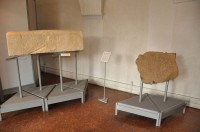Iron Age in the Area
Mid 10th century BC – Mid 1st century BC
The introduction of iron metallurgy and the development of the ancient Venetian civilization are the salient features of the Iron Age in Veneto.In Vicenza area, the oldest evidence can be attributed to occasional occupation of the area: a sword imported from southern Etruria (9th-8th century BC) ritually deposited in Astico River and a 7th-century BC logging axe from San Quirico-Valdagno.
Subsequently, numerous villages of semi-underground houses arose in Vicenza and Verona pre-Alpine area, during a veritable colonization of the territory by lowland centers, which reached its peak between the 5th and 4th centuries BC.In addition to agriculture and livestock farming, wool, ceramic, and metalworking flourished, as did trade with the lowland settlements and the neighboring Rhaetian and Celtic areas.
Locally produced vases were found in the village of Montebello Vicentino, as well as ceramics decorated with red and black bands imported from the lowland.Noteworthy are also locally produced umbilicated cups (5th century BC) from the village of Trissino, while the discovery of a fragment of Celtic-style silver torques and pig phalanges with Rhaetian inscriptions used for divination (2nd-1st century BC) has led to the identification of a cult area adjacent to the village.
Two important epigraphic documents are also on display: the stele from Villa Guiccioli, with a dedication to the liminal deities, one of the longest known Venetic inscriptions; and the one from Isola Vicentina, with a complex dedicatory formula in which the first epigraphic attestation of the ethnic Venetian term (Venetkens) appears.
Image Gallery
 |
 |

